How to Clean Bearded Dragon
To clean your bearded dragon, you'll need to establish a vital routine. Daily, remove leftover food and spot-clean feces. Weekly, perform a thorough enclosure cleaning, replacing substrate and disinfecting surfaces with a 1:1 vinegar-water solution. Monthly, conduct a deep clean, soaking removable items in F10SC disinfectant and completely replacing the substrate. Bathe your dragon regularly in shoulder-deep water for 15-20 minutes, using a soft-bristled toothbrush for gentle cleaning. Don't forget to trim nails as needed. Proper hygiene is indispensable for your dragon's health, preventing bacterial growth and respiratory issues. The following sections will provide more detailed insights into maintaining your bearded dragon's habitat.
This post may contain affiliate links. If you make a purchase through these links, I may earn a commission at no additional cost to you. Additionally, portions of this post may be generated using artificial intelligence (AI) technology. While we strive for accuracy, please be aware that AI-generated content may not always be perfect and should be fact-checked when necessary.
The Spatula Scoops
- Remove waste and uneaten food daily, spot-cleaning the enclosure with a 1:1 vinegar-water solution.
- Bathe your bearded dragon in shallow, shoulder-height water for 15-20 minutes to aid shedding and cleanliness.
- Replace substrate completely every 1-2 weeks, using safe options like reptile carpet or paper towels.
- Disinfect the entire enclosure monthly with a reptile-safe product, paying attention to areas where waste accumulates.
- Clean accessories like water dishes daily, and soak removable items in veterinary-grade disinfectant weekly.
Importance of Bearded Dragon Hygiene

Maintaining proper hygiene for your bearded dragon isn't just about keeping them looking good; it's essential for their overall health and well-being. These reptiles require regular cleaning to prevent the buildup of bacteria, parasites, and other harmful microorganisms that can lead to infections and diseases. You'll need to clean your bearded dragon's enclosure every day, removing waste and uneaten food to maintain a sanitary environment. Implementing a FIFO system for feeding can help reduce the risk of spoiled food contributing to odors and bacterial growth in the enclosure.
Proper hygiene also involves monitoring your pet's skin condition, as bearded dragons are prone to shedding. Regular baths can help with this process and keep their skin healthy. Additionally, cleanliness plays a pivotal role in preventing respiratory issues, which these lizards are susceptible to in dirty environments. By maintaining a clean habitat, you're also reducing the risk of unpleasant odors that can develop in neglected enclosures.
Daily Cleaning Routine
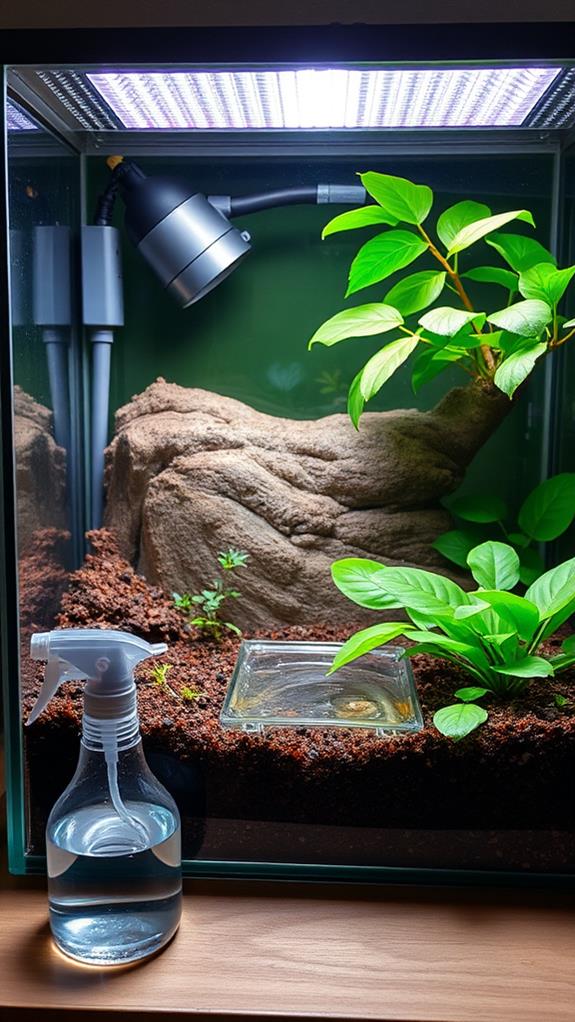
A consistent daily cleaning routine is essential for your bearded dragon's health. Start by removing any leftover food from the enclosure to prevent bacterial growth. Use a small brush or tongs to collect uneaten insects and vegetables. Next, spot-clean any feces or urates you find, using a paper towel or reptile-safe wipes. This step is imperative, as quick action helps prevent stains from setting in the substrate or surfaces of the enclosure, similar to how immediate action is important when dealing with ink stains on clothing.
For substrate cleaning, remove any soiled areas and replace them with fresh material. If you're using a non-particulate substrate like tile or liner, wipe it down with a mixture of white vinegar and water (1:1 ratio). This natural disinfectant is safe for your beardie and effectively eliminates bacteria.
Don't forget to clean the water dish daily. Empty it, scrub with a mild soap, rinse thoroughly, and refill with fresh water. Wipe down any surfaces your dragon has climbed on, including branches and basking spots. Use the vinegar and water solution for this task as well.
Lastly, check and clean any decorations or hiding spots in the enclosure. By maintaining this daily routine, you'll create a hygienic environment for your bearded dragon, reducing the risk of illness and promoting overall well-being.
Weekly Enclosure Maintenance
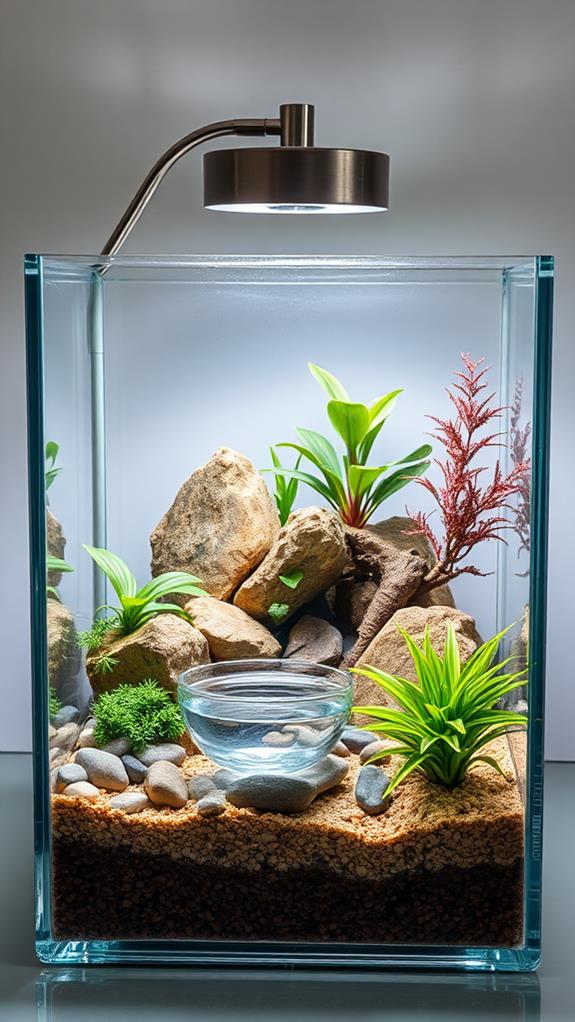
Weekly deep-cleaning sessions are crucial for your bearded dragon's habitat. As the first step, remove your pet and all removable items from the enclosure. Then, thoroughly clean the entire habitat, making certain you eliminate all fecal matter, uneaten food, and debris. Use a 1:1 mixture of white vinegar and water to disinfect surfaces, decor, and live plants. For efficient cleaning and storage, consider using silicone freezer molds to portion and freeze your bearded dragon's food in advance.
Replace the substrate with fresh, high-quality bedding to maintain a sanitary environment. For stubborn stains or residue, use a brush to scrub the enclosure walls and furnishings. Don't forget to soak removable items like water dishes and hides in a veterinary-grade disinfectant such as F10SC.
To make your weekly maintenance routine more manageable, follow these steps:
- Set a specific day and time for cleaning
- Gather all necessary supplies before starting
- Create a checklist to make certain you don't miss any areas
- Establish a post-cleaning inspection routine
Monthly Deep Clean Process

Your bearded dragon's enclosure requires a monthly deep clean to maintain ideal hygiene. This process involves a thorough disinfection, where you'll soak all removable items in F10SC disinfectant and scrub the enclosure with a brush to remove stubborn debris. You'll also need to completely replace the old substrate with fresh material, ensuring a clean environment for your pet.
Thorough Disinfection Process
Maintaining a pristine habitat for your bearded dragon requires a monthly deep clean process. This thorough disinfection process ensures your pet's environment remains hygienic and safe. To start, you'll need to soak all removable items in F10SC disinfectant, which effectively sanitizes the enclosure components.
Next, completely change out the old substrate to provide a fresh, clean habitat for your bearded dragon. This step is indispensable for maintaining optimal hygiene levels. Use a brush to scrub away any stubborn stains or built-up residue in the enclosure, paying close attention to corners and crevices.
For an even more thorough cleaning, consider using a steam cleaner. This optional step provides additional disinfection of the enclosure surfaces, eliminating harmful bacteria and parasites.
To complete the process, follow these steps:
- Prepare a 1:1 white vinegar and water solution
- Thoroughly wipe down the tank with the solution
- Rinse the enclosure with clean water
- Dry all surfaces completely before reintroducing your bearded dragon
Complete Substrate Replacement
A key component of the monthly deep clean process is the complete replacement of your bearded dragon's substrate. This pivotal step ensures a hygienic environment for your pet and helps prevent the buildup of harmful bacteria and parasites. Begin by removing your bearded dragon from its enclosure and placing it in a secure, temporary habitat.
Next, carefully remove all the existing substrate, making sure to dispose of it properly. You'll want to vacuum or wipe down the bare bottom of the enclosure to remove any remaining debris. Once clean, it's time to add fresh substrate. Choose a reptile-safe option such as reptile carpet, tile, or newspaper. If using loose substrate like sand or soil, guarantee it's specifically designed for bearded dragons to avoid impaction risks.
When laying down the new substrate, distribute it evenly across the enclosure's floor. Pay attention to the substrate's depth, typically 1-2 inches for loose materials. This process not only refreshes your pet's living space but also allows you to inspect the enclosure for any damage or areas needing repair. Regular substrate replacement is essential for maintaining ideal husbandry practices and promoting your bearded dragon's overall health.
Essential Cleaning Equipment
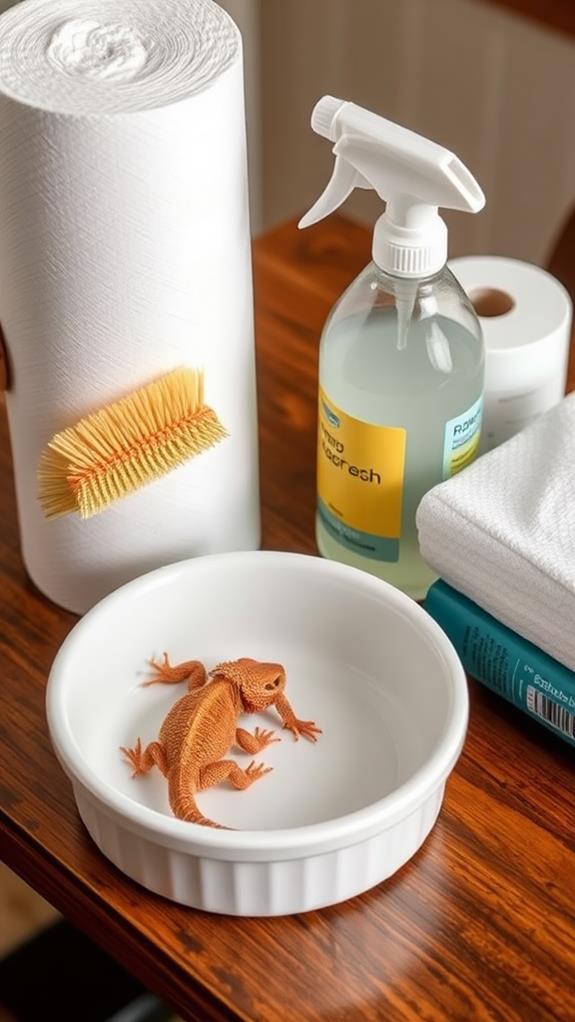
To clean your bearded dragon's enclosure safely and effectively, you'll need some essential equipment. Start with safety gear like a mask and gloves to protect yourself from harmful bacteria and contaminants. You'll also want to gather cleaning tools such as paper towels, a sieve, F10SC veterinary disinfectant, and a brush or scraper to make the process more efficient and thorough.
Safety Gear Essentials
When cleaning your bearded dragon's habitat, you'll need to protect yourself and guarantee thorough sanitation. Wearing a mask and gloves is essential to shield yourself from respiratory irritation and harmful bacteria. These safety measures are indispensable for maintaining your health while ensuring a clean environment for your pet.
To effectively clean and disinfect your bearded dragon's enclosure, you'll need:
- A mask and gloves for personal protection
- Paper towels for absorbing liquids and wiping surfaces
- A sieve for removing debris and waste
- F10SC veterinary-grade disinfectant for sanitizing
Using a 1:1 white vinegar and water solution is an excellent way to clean and sanitize removable items in the habitat. This mixture is effective and safe for your bearded dragon. For a more thorough cleaning, consider using a steam cleaner. This method can reach hard-to-clean areas and provide a deeper level of disinfection.
Remember to clean feeding bowls and other surfaces with the F10SC disinfectant to prevent the spread of parasites. By following these safety precautions and using the right cleaning tools, you'll create a healthy living space for your bearded dragon while protecting yourself in the process.
Cleaning Tools Overview
Maintaining a clean habitat for your bearded dragon requires the right tools for the job. Before you begin the cleaning process, gather all the necessary equipment to guarantee efficiency and thoroughness. You'll need a mask and gloves to protect yourself from potential pathogens when handling dirty items. Paper towels are essential for absorbing liquids and cleaning up messes quickly.
A sieve is a vital tool for removing debris, waste, and uneaten food from the enclosure. This helps maintain a hygienic environment for your pet. For effective sanitization, use F10SC, a veterinary-grade disinfectant that's safe for reptile habitats. This powerful cleaner will eliminate harmful bacteria and fungi.
To streamline your cleaning routine, keep all these items together in a designated cleaning kit. This might include a small bucket, scrub brushes, and a spray bottle for the disinfectant solution. Having everything at hand will make the task more manageable and guarantee you don't forget any essential steps. Remember, consistent cleaning with the right tools is key to maintaining a healthy habitat for your bearded dragon.
Bathing Your Bearded Dragon
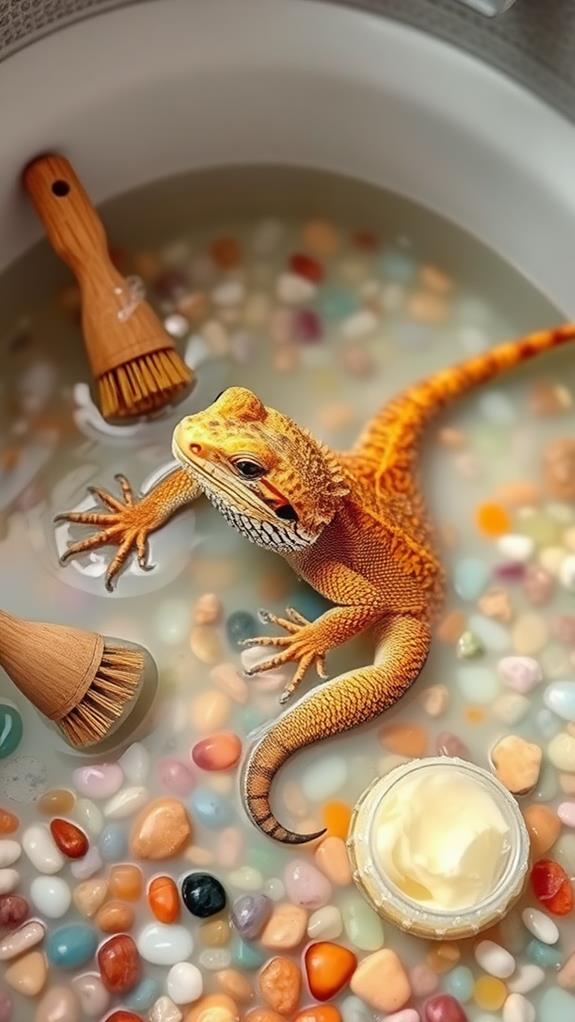
Regularly bathing your bearded dragon is an essential part of their care routine. To properly bathe your scaly friend, fill a shallow container with lukewarm water, making certain the water level doesn't exceed their shoulders. Gently place your dragon in the bath and use a soft, damp cloth or toothbrush to clean their body, being careful to avoid the head and eyes.
During the bath, you can:
- Encourage movement to stimulate digestion
- Check for any skin issues or abnormalities
- Help with shedding by gently rubbing loose skin
- Provide hydration, as some dragons may drink during bath time
Aim for a 15-20 minute soak, which can help with digestive issues and skin conditions. After bathing, thoroughly rinse your dragon to remove any soap or debris, then pat them dry with a clean towel. It bears mentioning that while bathing is beneficial, it shouldn't replace proper nutrition. Offer a varied diet with appropriate supplements to promote healthy skin and reduce the need for frequent bathing. By following these steps, you'll keep your bearded dragon clean and healthy.
Grooming Techniques
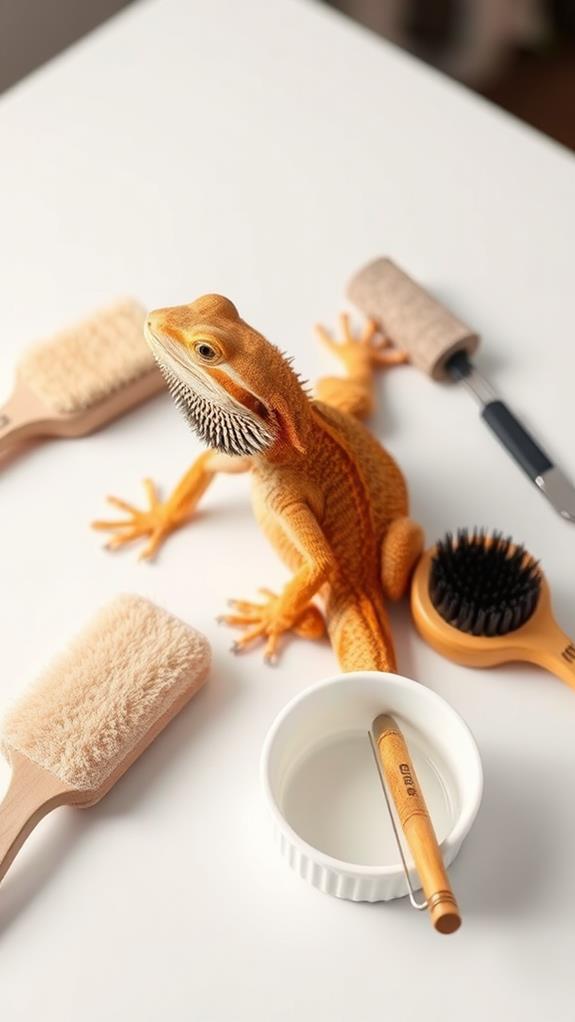
When grooming your bearded dragon, start with a gentle bath using a soft-bristle toothbrush and mild, unscented soap to remove dirt and debris. You'll need to carefully trim your pet's nails when they become too long, preventing potential injuries from overgrown claws. Regular bathing and nail maintenance are essential components of a thorough grooming routine, helping to keep your bearded dragon clean and healthy.
Bathing and Soap Selection
Bathing your bearded dragon is an essential part of their grooming routine. When selecting a soap, opt for a mild, unscented baby soap like Johnson's to prevent skin irritation. Avoid harsh chemicals or soaps that could disrupt your lizard's natural skin oils and overall health.
To properly bathe your bearded dragon:
- Fill a shallow container with lukewarm water.
- Gently place your lizard in the water, guaranteeing it's not too deep.
- Use a soft-bristled toothbrush to carefully scrub their body, paying extra attention to the nose, ears, and mouth areas.
- Rinse thoroughly with clean water to remove all soap residue.
Establish a consistent bathing schedule to maintain your bearded dragon's cleanliness and hygiene. This routine not only keeps your pet clean but also allows you to inspect their body for any abnormalities or health concerns. Remember to trim your lizard's nails when they become overgrown, as this prevents discomfort and potential injury. By following these guidelines, you'll secure your bearded dragon remains healthy, clean, and comfortable in their environment.
Nail Trimming Techniques
Nail trimming is an essential aspect of bearded dragon grooming. You'll need to trim your pet's nails every 4-6 weeks to prevent overgrowth and safeguard their comfort. To do this effectively, invest in sharp, high-quality nail clippers designed specifically for reptiles.
When trimming, you'll want to cut just below the quick, which is the blood vessel inside the nail. This approach minimizes the risk of bleeding and discomfort for your bearded dragon. If you accidentally cut too close and cause minor bleeding, don't panic. Apply a small amount of styptic powder or cornstarch to help stop the bleeding.
Proper nail trimming technique is indispensable for maintaining your bearded dragon's foot health and mobility. As you become more familiar with the process, you'll develop a routine that works best for you and your pet. Remember, consistency is key. Regular trimming prevents nails from becoming too long, which can lead to difficulty walking or even injuries.
Substrate Cleaning and Replacement
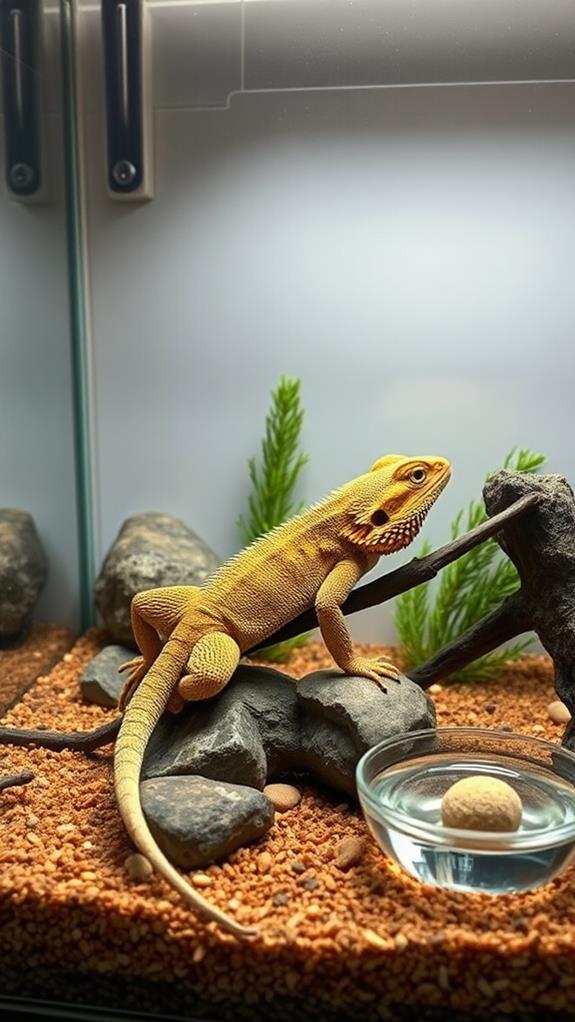
A clean substrate is crucial for your bearded dragon's health and well-being. Dirty bedding can harbor harmful bacteria and parasites, potentially leading to serious health issues for your pet. To maintain a sanitary environment, you should spot clean the substrate daily, removing any feces or uneaten food. Every 1-2 weeks, depending on your enclosure's size and the number of dragons housed, you'll need to completely replace the substrate.
When choosing a substrate for your bearded dragon, opt for safe options like:
- Reptile carpet
- Paper towels
- Cypress mulch
- Coconut fiber
These choices provide a comfortable surface for your dragon while minimizing the risk of ingestion. Avoid loose substrates like sand, which can cause intestinal blockages if swallowed.
To clean the substrate effectively, follow these steps:
- Remove your dragon from the enclosure
- Discard the old substrate
- Thoroughly clean and disinfect the enclosure
- Add fresh, clean substrate
Disinfecting the Enclosure

In addition to regular substrate cleaning, disinfecting your bearded dragon's enclosure is essential for maintaining a healthy habitat. You'll need to perform a thorough disinfection at least once a month, or more frequently if your pet has been ill.
Start by removing your bearded dragon and all items from the enclosure. Prepare a solution of reptile-safe disinfectant according to the manufacturer's instructions. Use this solution to clean all surfaces of the enclosure, including walls, floors, and corners. Pay special attention to areas where waste accumulates. Scrub with a soft brush to remove any stubborn debris or bacteria.
After cleaning, rinse the enclosure thoroughly with clean water to remove any disinfectant residue. Dry the habitat completely using paper towels or a clean cloth. While the enclosure dries, take this opportunity to disinfect all accessories, such as food and water dishes, hiding spots, and climbing structures. Once everything is clean and dry, reassemble the habitat with fresh substrate and return your bearded dragon to its newly sanitized home.
Regular disinfection helps prevent the buildup of harmful bacteria and parasites, ensuring a safe environment for your pet.
Health Monitoring During Cleaning
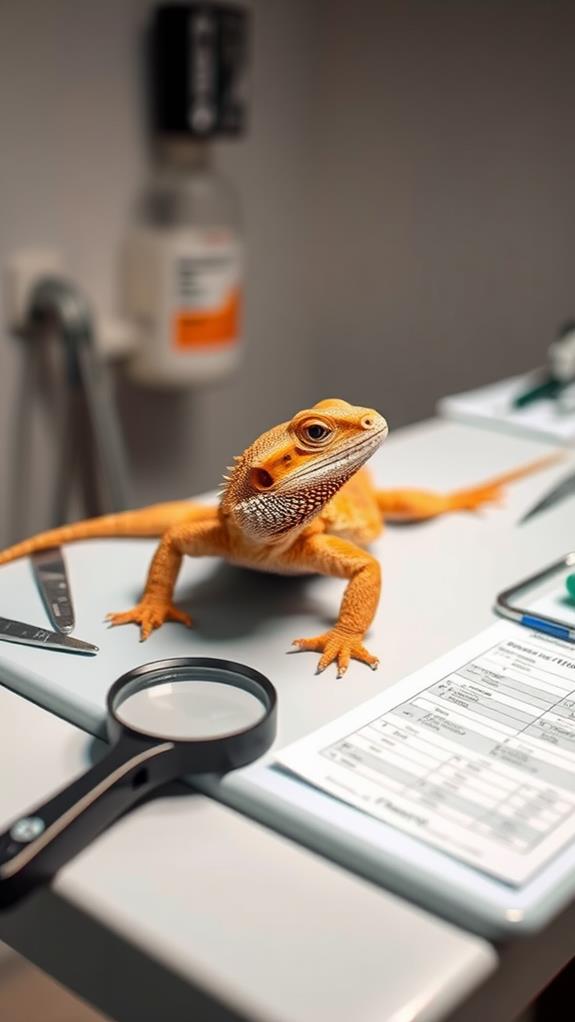
The first sentence in the text is: Cleaning time provides an excellent opportunity to monitor your bearded dragon's health closely. As you clean, pay attention to your pet's overall condition and behavior. You'll want to:
- Inspect your dragon's body thoroughly for any signs of skin irritations, wounds, or abnormalities
- Check the eyes, nose, and mouth for discharges or swelling
- Observe the consistency and color of droppings
- Monitor your pet's alertness and stress levels throughout the process
Look for any respiratory issues, such as wheezing or labored breathing. These could indicate a potential health concern that requires veterinary attention. Examine your dragon's limbs and joints for any swelling or difficulty in movement. As you handle your pet, note its body temperature and muscle tone. If you notice any unusual changes or behaviors, it's best to consult with a reptile veterinarian. Remember, early detection of health issues can lead to more effective treatment. By incorporating health monitoring into your regular cleaning routine, you're taking proactive steps to safeguard your bearded dragon's well-being and longevity.
Frequently Asked Questions
Are You Supposed to Bathe Bearded Dragons?
You don't need to bathe your bearded dragon regularly. While occasional shallow soaks can help with shedding and hydration, full-body baths aren't necessary and can be stressful. Instead, focus on spot-cleaning with a soft cloth or toothbrush and mild soap. Provide a shallow water dish in their enclosure and mist it occasionally to meet their hydration needs. Be cautious with water exposure, as too much can lead to respiratory issues in these lizards.
What Can I Use to Clean My Bearded Dragon?
Carefully cleaning your critter can be vital for its comfort. You can use lukewarm water to gently bathe your bearded dragon. Avoid soaps or harsh chemicals, as they can irritate your pet's skin. Instead, use a soft-bristled toothbrush to scrub away any dirt or debris. For stubborn spots, you can create a mild solution of water and reptile-safe disinfectant. Always rinse thoroughly and dry your dragon completely after cleaning to prevent skin issues.
How Often Should You Clean a Bearded Dragon?
You should clean your bearded dragon regularly to maintain its health. Spot-clean its enclosure daily, removing waste and uneaten food. Perform a thorough cleaning weekly, including replacing substrate and disinfecting surfaces. Bathe your bearded dragon every 1-2 weeks, or more frequently if it's shedding or dirty. However, don't overdo it; excessive bathing can stress your pet. Always use lukewarm water and gentle cleaning methods. Adjust the frequency based on your dragon's specific needs and environment.
Is Dawn Dish Soap Safe for Bearded Dragons?
No, Dawn dish soap isn't safe for bearded dragons. You shouldn't use it to clean your pet as it's too harsh for their sensitive skin. Dawn can strip away natural oils, leading to dryness and potential health issues. Instead, opt for gentle, reptile-safe soaps like Johnson's baby soap or specialized reptile shampoos. These milder options are formulated to clean without irritating your bearded dragon's delicate skin. Remember to rinse thoroughly after bathing to remove any soap residue.





